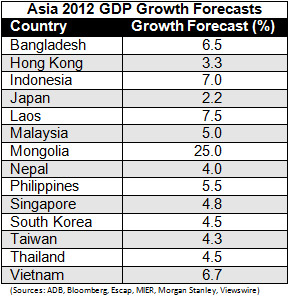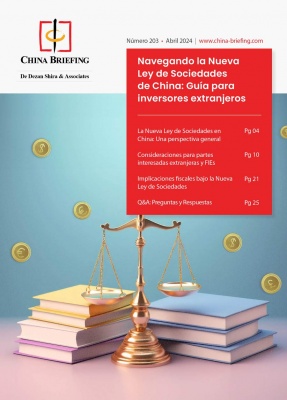The China Ripples – Emerging Asia Beckons
China’s 2012 growth rates compared with other emerging Asian economies
Op-Ed Commentary: Chris Devonshire-Ellis
Jan. 23 – The development of China over the past 30 years has changed global trade dynamics beyond imagination. That it is also kick-starting a previously laid back Asia is also beyond doubt, and of huge strategic importance to multinationals keen to maintain growth rates and sustainable profits.
As much of the West continues to struggle with the lingering fallout of the Global Financial Crisis, and with low growth rates expected everywhere across the United States and most of Europe, getting growth back into multinational companies not already expanding in Asia is a task that unites the entire Eurozone and the United States. With GDP growth in all these areas either minimal, static or at worst, entering recession, emerging Asia offers a way out. Growth in China has been slowing, but it is still buoyant at an expected 7 percent to 8 percent for 2012; and India has recently overtaken China in terms of the highest GDP growth of a major global economy. India’s GDP is expected to grow by 8.5 percent to 9 percent this year.
Just two weeks ago, India relaxed regulatory controls over single brand retailers, offering many global brands the ability to own 100 percent of their own stores – and profits – in the country. India has also reached further than China in its reforms by permitting individual investors to purchase Indian stocks directly – something that is still off limits in Mainland China, and likely to remain so for some time. Both moves are expected to add billions of dollars to India’s FDI figures for 2012.
That India represents a ready market is apparent when Hermes, the luxury French fashion designer, has launched a range of saris costing up to US$8,000 – a case of apparently selling coals to Newcastle if there ever was one. The items have almost sold out such is the demand for luxury items in traditional Indian style, even from foreign designers. These developments are indicative of a wealthy and vibrant consumer market. India is about to become the darling of foreign investors, and the manner in which China and India both compete and complement each other in terms of strategic development will be fascinating to observe.
However, the potential does not just lie with these two and economies elsewhere throughout Asia are set for some spectacular returns. Other Asian markets have also been showing strong growth, with 2012 forecasts as follows:

Of these, Mongolia stands out with an astonishing 25 percent GDP growth expected, largely as a result of both its relatively slow starting base and the massive upsurge in mining investment currently taking place in the country. Japan, meanwhile, remains low at under 3 percent as the nation still deals with the devastating effects of last year’s tsunami.
Elsewhere in Asia, growth is significantly better than in the West, with China, India, Indonesia and Vietnam all extremely strong. Bangladesh and Cambodia are also predicted to have strong economic performances during 2012, driven both by their increasing trade volumes with ASEAN and also as a result of the migration away from China of cheap, labor-intensive industries (the garment/textiles sector in particular).
ASEAN – which incorporates much of Southeast Asia – features Singapore as its de facto financial center and possesses a market of some 560 million Asian consumers. With emerging nations such as Cambodia and Vietnam, among others, the fact that both China and India possess FTA agreements with the regional body augurs well for basing a company in Singapore and using that to take advantage of cheap ASEAN labor while reaching out simultaneously towards the huge consumer markets of India and China.
Investment into Asia then will become a watch word for global business trends during 2012 – with the phenomena of China’s massive rise over the past 30 years having a ripple effect upon all other Asian economies. We have written about this extensively at China Briefing – for more specific country details please refer to our “China Alternative” series, and for tax comparisons to last month’s issue of China Briefing Magazine “The Asia Tax Comparator.”
Emerging Asia is beckoning, and global entrepreneurs, designers, manufacturers and retailers should be taking note of the strategic issues for their business development.
Chris Devonshire-Ellis is the principal and founding partner of Dezan Shira & Associates, a foreign direct investment practice specializing in providing legal, tax, due diligence and financial advice to foreign investors throughout Asia. The firm was established in 1992 and maintains numerous offices in China, Hong Kong, India, Singapore and Vietnam. Please visit the firm’s web site or contact them at asia@dezshira.com.
Related Reading
 The Asia Tax Comparator
The Asia Tax Comparator
Asia Briefing devotes this issue of China Briefing to providing a practical comparison of taxation throughout Asia. In particular, this issue takes a look at the taxes most applicable to foreign businesses and individuals in Asia, i.e., corporate income tax, value-added tax, goods and service tax, standard tax on dividends and individual income tax. Priced at US$25.
 The China Alternative
The China Alternative
Our complete series on other manufacturing destinations in Asia that are now starting to compete with China in terms of labor costs, infrastructure and operational capacity.
The Three Pronged Strategy for Investing in Asia’s Massive Growth
- Previous Article China, UK Announce Joint Scientific Research Projects
- Next Article U.S. to Investigate Wind Tower Imports from China, Vietnam
























